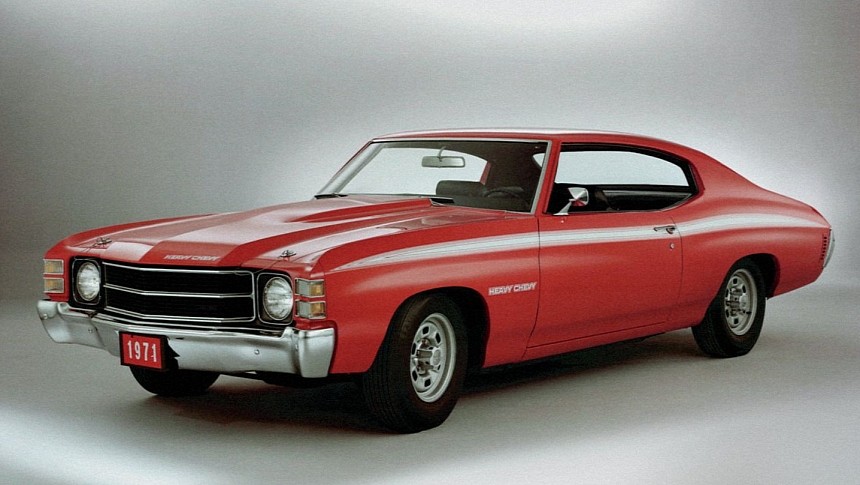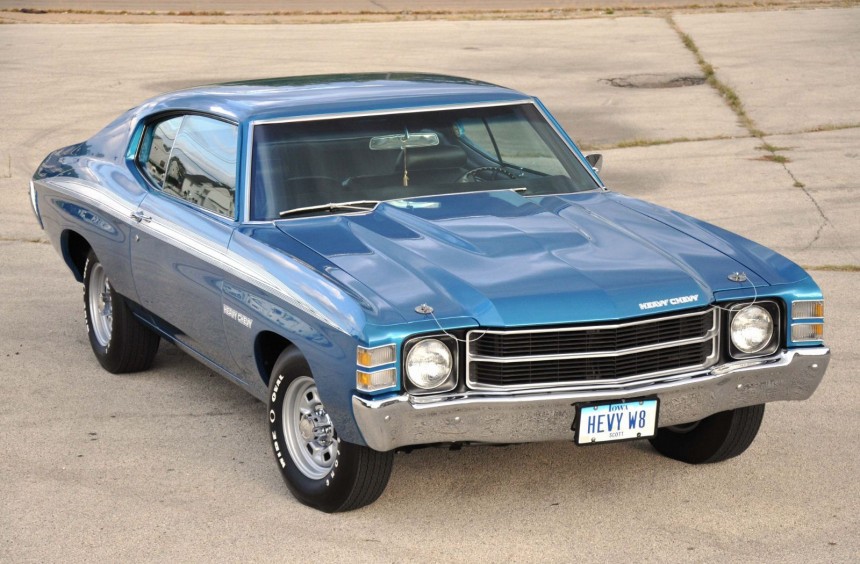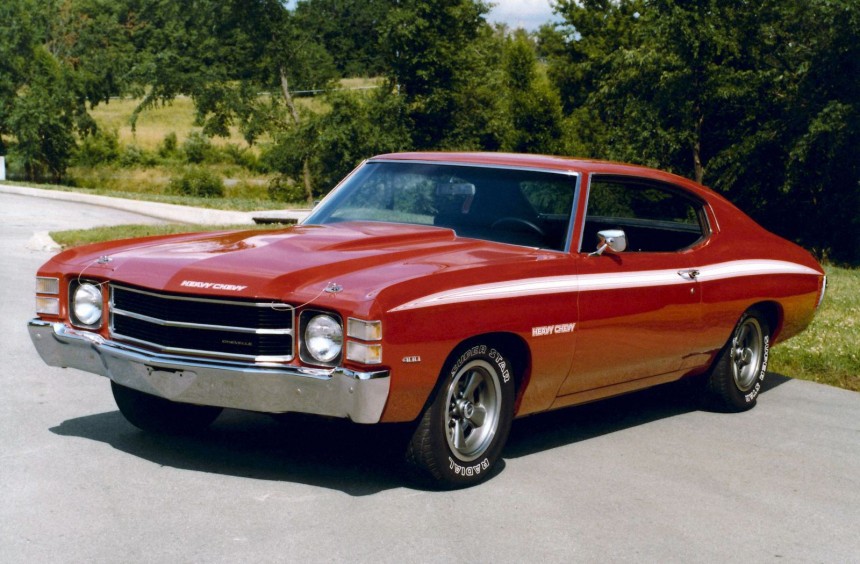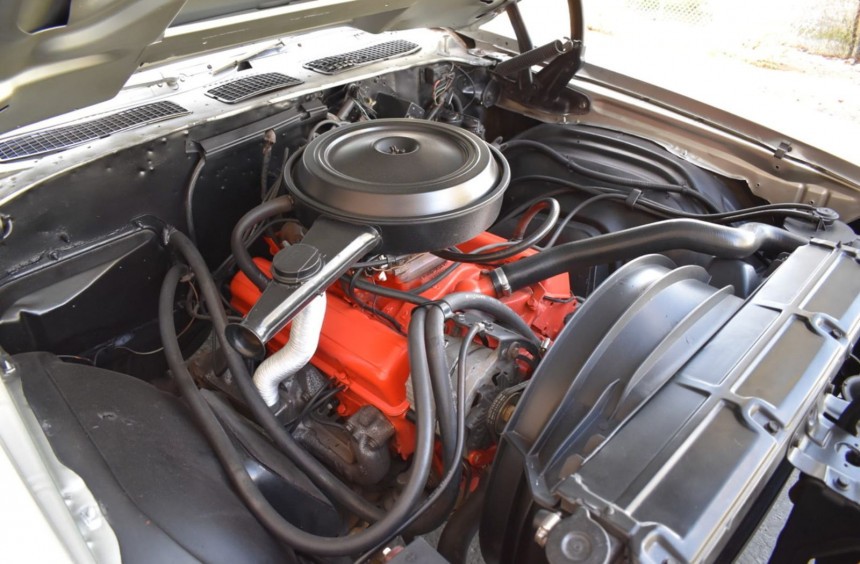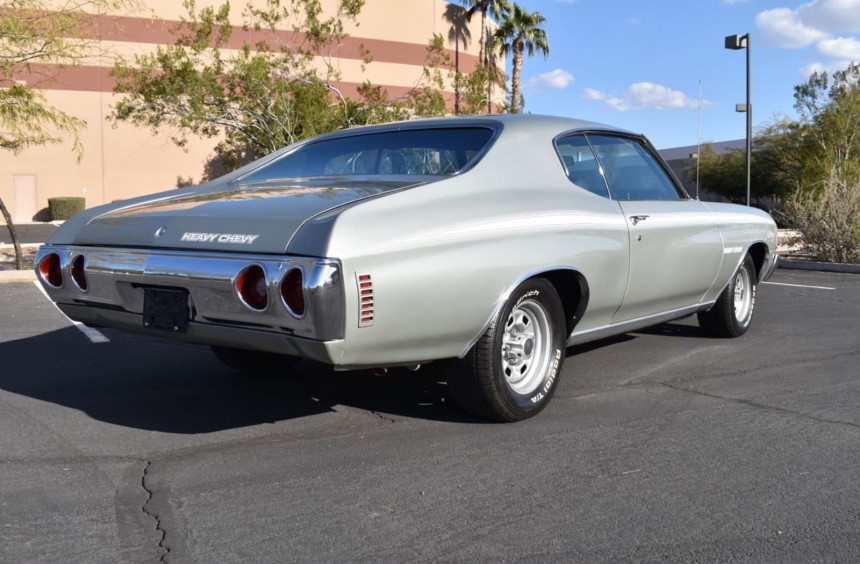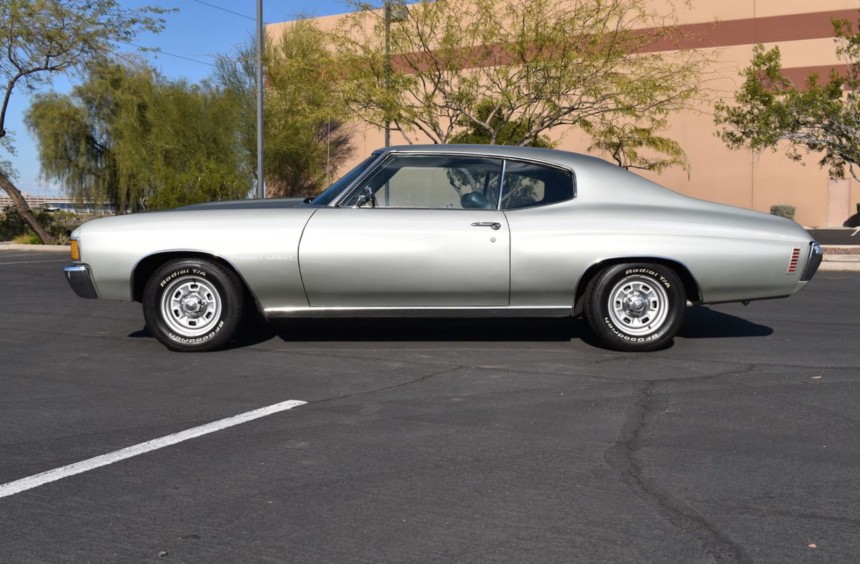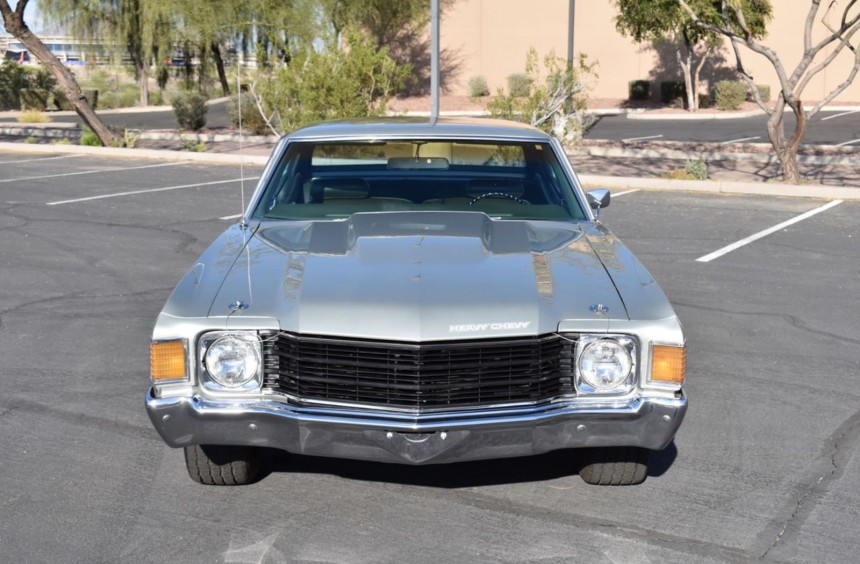As it was back in 71-72, the Heavy Chevy is the perfect choice for second-generation Chevelle fans who can't afford an SS but want more of a muscle car than the standard Malibu sport coupe.
Apart from legendary models like the HEMI-powered Mopars, 454 LS6 Chevelles, or Cobra Jet-powered Ford, Detroit's Big Three capitalized on the muscle car craze of the late sixties and early seventies by introducing some budget-friendly rides.
The most famous remain the Plymouth Road Runner and its Dodge sibling, the Super Bee, which offered flashy looks with more ordinary standard hardware for an attractive sticker price.
While the Road Runner has become extremely saught-after today, fetching hefty sums when going under the hammer, the Super Bee is still quite an affordable classic - when it's not powered by the 440 Six-Pack or the rare HEMI option.
But, if you're more of a Chevy guy and have a soft spot for the third-gen Chevelle, there's another budget-friendly classic that many enthusiasts have forgotten all about.
Discontinued in 1977, the Chevelle was Chevy's jack-of-all-trades intermediate during its fourteen-year run.
Marketed as a sedan, wagon, pickup (dubbed El Camino) coupe, and convertible, the Chevelle was Chevrolet's best-selling passenger car for several model years.
In SS guise, it was also one of the Bowtie brand's most sought-after muscle cars, reaching the pinnacle of performance in 1970 when the 454 LS6 engine became available.
But, by 1971, stricter emission regulations and skyrocketing insurance premiums meant that potential buyers thought twice before buying a muscle car.
With sales of the SS-badged Chevelles projected to drop, Chevy management decided to give young muscle car enthusiasts a low-priced, cheaper-to-insure alternative.
Introduced mid-model year and marketed under the slogan "Heavy on looks and light on price," the alternative dubbed Heavy Chevy was only available in Chevelle sport coupe guise, carrying a sticker price of around $3,100 - about $500 less than a base SS and $200 more than a base sport coupe.
Like its more glamorous sibling, the Heavy Chevy stood out from the crowd of standard Chevelles thanks to several exterior enhancements.
Apart from the eye-catching colors that one could choose from, the budget-friendly muscle car received bespoke stripes on each side, Heavy Chevy decals, a blacked-out front grille, a domed hood with motorsport-inspired hood pins, and a set of 14-inch Rally wheels with unique hub caps and chromed-out lug nuts.
While the exterior enhancements made it clear this wasn't a standard Chevele, the interior was as basic as possible.
The model came with a front bench seat and rubber floor mats, but unlike the SS, options like bucket seats or a center console were not available for Heavy Chevys.
Unlike the base Chevelle, which came with a standard 230-ci (3.8-liter) Turbo-Thrift inline-six, the Heavy Chevy was only available with a V8 under the hood.
The standard engine was the Turbo-Fire 307 with a two-barrel carburetor rated at 200 hp. Next in line was the Turbo-Fire 350 with a two- or four-barrel carb that made 245 or 275 hp.
While the top-performing 454-ci (7.4-liter) LS5 (the LS6 was discontinued after the 1970 model) was only available on the SS, Heavy Chevy buyers who wanted more power than what the 350 could offer were able to get the 402-ci (6.6-liter) Turbo-Jet 400 big-block rated at 300 hp.
The transmissions available with the 307 were a standard three-speed manual, an optional two-speed Powerglide, and a three-speed Turbo Hydra-Matic (also optional).
For the 350 and 400, the same three-speed manual was standard, while the optional gearboxes included the Turbo Hydra-Matic or a four-speed manual.
Power was sent to the rear wheels through either an 8.125-inch "10-bolt" rear end (standard with the 307 and two-barrel 350) or a sturdier 8.875-inch "12-bolt" (standard with the four-barrel 350 and 400) version.
Buyers could also get a Positraction limited-slip differential with either axle for an extra $47.40.
The Heavy Chevy's standard brakes and suspension were the same as the Chevelle Sports coupe it was based on.
Nevertheless, the car's setup could be improved with power-assisted front drums or discs with single-piston calipers (also power assisted.)
Furthermore, the options list included the beefier F40 front suspension or the F41 heavy-duty package, which came standard on the Chevelle SS.
The F41 package was only available on 400-powered Heavy Chevys, adding heavy-duty shocks and springs, front and rear sway bars, and rear axle control arms.
The first reason why you should consider buying an example of this forgotten budget muscle is the fact that it's still budget-friendly today.
According to Hagerty, the average value for a 1971 350 four-barrel example in excellent condition currently stands at only $29,700, while a 1972 model with the same engine goes for 28,800.
Of course, the much rarer 400-powered cars are a different story, with values usually exceeding $50,000 for excellent-condition survivors.
Other reasons are the beauty of the second-generation Chevelle Sports coupe body mixed with the unique Heavy Chevy decals, the reliability of the drivetrains, and the availability of spare parts and aftermarket upgrades that make the car easy to live with.
Last but not least, with only 16,235 total units produced in both model years, the Heavy Chevy is a reasonably rare muscle car that will only become more expensive as the years go by, so it can prove to be an excellent investment in the long run.
So, if you're a fan of the second-generation Chevelle but can't afford an SS, the Heavy Chevy is an excellent, budget-friendly alternative.
You can watch a very cool 1971 Heavy Chevy commercial in the YouTube video below by Crosscut Films.
The most famous remain the Plymouth Road Runner and its Dodge sibling, the Super Bee, which offered flashy looks with more ordinary standard hardware for an attractive sticker price.
While the Road Runner has become extremely saught-after today, fetching hefty sums when going under the hammer, the Super Bee is still quite an affordable classic - when it's not powered by the 440 Six-Pack or the rare HEMI option.
But, if you're more of a Chevy guy and have a soft spot for the third-gen Chevelle, there's another budget-friendly classic that many enthusiasts have forgotten all about.
A short history of the 1971-1972 Heavy Chevy
Marketed as a sedan, wagon, pickup (dubbed El Camino) coupe, and convertible, the Chevelle was Chevrolet's best-selling passenger car for several model years.
In SS guise, it was also one of the Bowtie brand's most sought-after muscle cars, reaching the pinnacle of performance in 1970 when the 454 LS6 engine became available.
But, by 1971, stricter emission regulations and skyrocketing insurance premiums meant that potential buyers thought twice before buying a muscle car.
With sales of the SS-badged Chevelles projected to drop, Chevy management decided to give young muscle car enthusiasts a low-priced, cheaper-to-insure alternative.
Introduced mid-model year and marketed under the slogan "Heavy on looks and light on price," the alternative dubbed Heavy Chevy was only available in Chevelle sport coupe guise, carrying a sticker price of around $3,100 - about $500 less than a base SS and $200 more than a base sport coupe.
Muscle car looks
Apart from the eye-catching colors that one could choose from, the budget-friendly muscle car received bespoke stripes on each side, Heavy Chevy decals, a blacked-out front grille, a domed hood with motorsport-inspired hood pins, and a set of 14-inch Rally wheels with unique hub caps and chromed-out lug nuts.
While the exterior enhancements made it clear this wasn't a standard Chevele, the interior was as basic as possible.
The model came with a front bench seat and rubber floor mats, but unlike the SS, options like bucket seats or a center console were not available for Heavy Chevys.
Four V8s to choose from
The standard engine was the Turbo-Fire 307 with a two-barrel carburetor rated at 200 hp. Next in line was the Turbo-Fire 350 with a two- or four-barrel carb that made 245 or 275 hp.
While the top-performing 454-ci (7.4-liter) LS5 (the LS6 was discontinued after the 1970 model) was only available on the SS, Heavy Chevy buyers who wanted more power than what the 350 could offer were able to get the 402-ci (6.6-liter) Turbo-Jet 400 big-block rated at 300 hp.
Solid gearbox and rear axle choices
For the 350 and 400, the same three-speed manual was standard, while the optional gearboxes included the Turbo Hydra-Matic or a four-speed manual.
Power was sent to the rear wheels through either an 8.125-inch "10-bolt" rear end (standard with the 307 and two-barrel 350) or a sturdier 8.875-inch "12-bolt" (standard with the four-barrel 350 and 400) version.
Buyers could also get a Positraction limited-slip differential with either axle for an extra $47.40.
Available with SS-level chassis upgrades
Nevertheless, the car's setup could be improved with power-assisted front drums or discs with single-piston calipers (also power assisted.)
Furthermore, the options list included the beefier F40 front suspension or the F41 heavy-duty package, which came standard on the Chevelle SS.
The F41 package was only available on 400-powered Heavy Chevys, adding heavy-duty shocks and springs, front and rear sway bars, and rear axle control arms.
Why should you buy a Heavy Chevy today?
According to Hagerty, the average value for a 1971 350 four-barrel example in excellent condition currently stands at only $29,700, while a 1972 model with the same engine goes for 28,800.
Of course, the much rarer 400-powered cars are a different story, with values usually exceeding $50,000 for excellent-condition survivors.
Other reasons are the beauty of the second-generation Chevelle Sports coupe body mixed with the unique Heavy Chevy decals, the reliability of the drivetrains, and the availability of spare parts and aftermarket upgrades that make the car easy to live with.
Last but not least, with only 16,235 total units produced in both model years, the Heavy Chevy is a reasonably rare muscle car that will only become more expensive as the years go by, so it can prove to be an excellent investment in the long run.
So, if you're a fan of the second-generation Chevelle but can't afford an SS, the Heavy Chevy is an excellent, budget-friendly alternative.
You can watch a very cool 1971 Heavy Chevy commercial in the YouTube video below by Crosscut Films.
